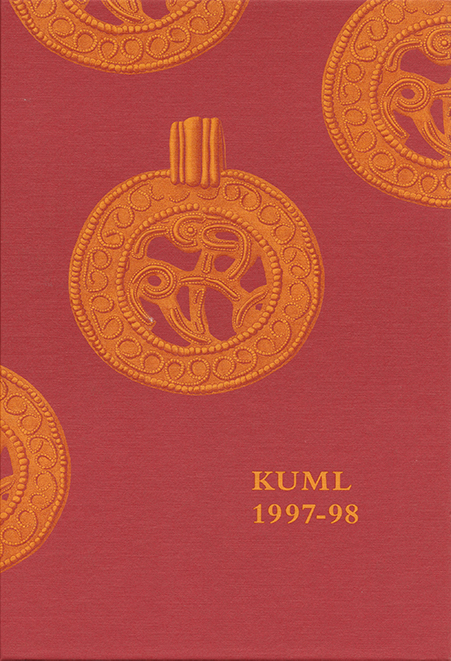A snekke came…
Harbour sites from the 11th and 12th centuries?
DOI:
https://doi.org/10.7146/kuml.v41i41.113368Keywords:
Snekke, harbor sites, 11th and 12th centuries, fribrødre å, Viking age, early medieval period, place-namesAbstract
A snekke came ...
Harbour sites from the 11th and 12th centuries?
During recent years the Viking Ship Museum in Roskilde -in collaboration with the National Museum and the Museum of Falsters Minder- has undertaken archaeological investigations along Fribrødre Å (the word å means stream or small river in Danish) on Northern Falster (fig. 1). As a result, large parts of a continuous find layer, mainly consisting of wood waste, tools and ship parts, have been excavated (fig. 2 and 3). The ship parts found all came from ships built according to the Nordic tradition, as we know it, from the Viking Age and early Medieval Period. It is characteristic of the parts found that they were worn or destroyed items, and so they have been interpreted as waste from repairing or scrapping work. The activity that led to the creation of the layer is presumed to have been carried out for a considerable period of time, for the finds date to the period between the early 11th century and the second half of the 12th.
In the first years of the excavation the site was interpreted as a proper shipyard, but further investigation has changed or adjusted this interpretation. We now think that we are dealing with a harbour where ships were repaired and maintained.
Three place-names -Nørre Snekkebjerg, Sønder Snekkebjerg and Snekketefter- near the site are thought to be connected with it (the word snekke is an old Danish word for a small vessel, and the place-names may be translated as 'the Northern Snekke Hill','The Southern Snekke Hill' and 'Snekke Tofts', respectively). Attention has therefore been directed towards the word snekke in order to find out whether the site at Fribrødre Å is a unique locality, or whether an investigation combining finds and place-names may lead us to other, similar harbour sites.
The word snekke occurs in several placenames of Nordic origin. Most of these names are found in Norway, Finland, Sweden and Denmark, but there are also a few in Shetland and the Orkneys.
In Old Swedish and Norwegian-Icelandic texts the word snekke is mainly used for a warship. The Danish texts do not reveal much as regards the form and function of this type of ship, but the word probably had the same specific meaning in Old Danish as in the other Nordic languages. In Denmark the word fell out of use in the course of the Middle Ages but after 1700 it was reintroduced from older sources.
A registration of those Danish place-names which are thought to contain the word snekke has been carried out. This resulted in a catalogue consisting of 100 names, of which most are connected to fields or sites which were recorded for the first time in the registers of 1681-83 made in preparation for the land register of King Christian V. An attempt was then made to localise these names using maps from the land reform of around 1800 and other map material (fig. 6).
As part of a place-name the word snekke may refer to a number of different concepts, but the majority of the Snekke-names in the catalogue probably point to activities with real ships. The names usually consist of snekke as first element and a second element pointing to the type of site. Among the second elements only the words gård ('farm') and torp ('dependent settlement') originally denoted settlements. Gård is used as the second element of a farm name in Northwestern Zealand, which was first recorded rather late. Torp (in a metatbesised form) is the second element of two Zealandic village names: Snekkerup. The rest of the names indicate ridges, cultivated areas, wetlands etc. Snekke is most frequently used in combination with the word bjerg ('hill'), which occurs in 21 place-names.
The registered Snekke-sites are scattered along the Danish coasts. All the sites have been accessible by ship. They typically have an inland situation, secluded and protected from attack from the coast.
On this basis it seems reasonable to conclude that the Snekke-names were formed in connection with ship activity in the Viking Age and the Early Middle Ages. Moreover, the finds and local conditions at Fribrødre Å make it most likely that we are dealing with local harbours.
Thus it should be possible to confirm the presence of ship-related activity by archaeological means at least at some of the registered Snekke-sites. However, the circumstances are difficult. The find layers at Fribrødre Å revealed that the remains from work on ships mainly consist of wood, and such layers have disappeared from most places -dried out as a result of the lowering of the water level since the Viking Age and Middle Ages (fig. 7).
Bente Holmberg, Jan Skamby Madsen
Downloads
Published
How to Cite
Issue
Section
License
Fra og med årgang 2022 er artikler udgivet i Kuml med en licens fra Creative Commons (CC BY-NC-SA 4.0).
Alle tidligere årgange af tidsskriftet er ikke udgivet med en licens fra Creative Commons.


